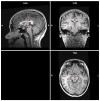Oxytocin increases VTA activation to infant and sexual stimuli in nulliparous and postpartum women
- PMID: 25562711
- PMCID: PMC4418634
- DOI: 10.1016/j.yhbeh.2014.12.009
Oxytocin increases VTA activation to infant and sexual stimuli in nulliparous and postpartum women
Abstract
After giving birth, women typically experience decreased sexual desire and increased responsiveness to infant stimuli. These postpartum changes may be viewed as a trade-off in reproductive interests, which could be due to alterations in brain activity including areas associated with reward. The goal of this study was to describe the roles of oxytocin and parity on reward area activation in response to reproductive stimuli, specifically infant and sexual images. Because they have been shown to be associated with reward, the ventral tegmental area (VTA) and nucleus accumbens (NAc) were targeted as areas of expected alterations in activity. Oxytocin was chosen as a potential mediator of reproductive trade-offs because of its relationship to both mother-infant interactions, including breastfeeding and bonding, and sexual responses. We predicted that postpartum women would show higher reward area activation to infant stimuli and nulliparous women would show higher activation to sexual stimuli and that oxytocin would increase activation to infant stimuli in nulliparous women. To test this, we measured VTA and NAc activation using fMRI in response to infant photos, sexual photos, and neutral photos in 29 postpartum and 30 nulliparous women. Participants completed the Sexual Inhibition (SIS) and Sexual Excitation (SES) Scales and the Brief Index of Sexual Function for Women (BISF-W), which includes a sexual desire dimension, and received either oxytocin or placebo nasal spray before viewing crying and smiling infant and sexual images in an fMRI scanner. For both groups of women, intranasal oxytocin administration increased VTA activation to both crying infant and sexual images but not to smiling infant images. We found that postpartum women showed lower SES, higher SIS, and lower sexual desire compared to nulliparous women. Across parity groups, SES scores were correlated with VTA activation and subjective arousal ratings to sexual images. In postpartum women, sexual desire was positively correlated with VTA activation to sexual images and with SES. Our findings show that postpartum decreases in sexual desire may in part be mediated by VTA activation, and oxytocin increased activation of the VTA but not NAc in response to sexual and infant stimuli. Oxytocin may contribute to the altered reproductive priorities in postpartum women by increasing VTA activation to salient infant stimuli.
Keywords: Nucleus accumbens; Oxytocin; Postpartum; Reward; Sexual and infant stimuli; Ventral tegmental area.
Copyright © 2015 Elsevier Inc. All rights reserved.
Figures




Similar articles
-
Lower sexual interest in postpartum women: relationship to amygdala activation and intranasal oxytocin.Horm Behav. 2013 Jan;63(1):114-21. doi: 10.1016/j.yhbeh.2012.10.007. Epub 2012 Oct 18. Horm Behav. 2013. PMID: 23085496 Free PMC article.
-
Neural correlates of emotion processing comparing antidepressants and exogenous oxytocin in postpartum depressed women: An exploratory study.PLoS One. 2019 May 31;14(5):e0217764. doi: 10.1371/journal.pone.0217764. eCollection 2019. PLoS One. 2019. PMID: 31150502 Free PMC article.
-
Amygdala response to negative images in postpartum vs nulliparous women and intranasal oxytocin.Soc Cogn Affect Neurosci. 2014 Jan;9(1):48-54. doi: 10.1093/scan/nss100. Epub 2012 Sep 5. Soc Cogn Affect Neurosci. 2014. PMID: 22956670 Free PMC article. Clinical Trial.
-
A neurobehavioral model of affiliative bonding: implications for conceptualizing a human trait of affiliation.Behav Brain Sci. 2005 Jun;28(3):313-50; discussion 350-95. doi: 10.1017/S0140525X05000063. Behav Brain Sci. 2005. PMID: 16209725 Review.
-
The antero-posterior heterogeneity of the ventral tegmental area.Neuroscience. 2014 Dec 12;282:198-216. doi: 10.1016/j.neuroscience.2014.09.025. Epub 2014 Sep 18. Neuroscience. 2014. PMID: 25241061 Review.
Cited by
-
The effect of intra-vaginal oxytocin on sexual function in breastfeeding mothers: a randomized triple-blind placebo-controlled trial.BMC Pregnancy Childbirth. 2022 Jan 22;22(1):62. doi: 10.1186/s12884-022-04384-w. BMC Pregnancy Childbirth. 2022. PMID: 35065634 Free PMC article. Clinical Trial.
-
Intranasal oxytocin, but not vasopressin, augments neural responses to toddlers in human fathers.Horm Behav. 2017 Jul;93:193-202. doi: 10.1016/j.yhbeh.2017.01.006. Epub 2017 Feb 1. Horm Behav. 2017. PMID: 28161387 Free PMC article. Clinical Trial.
-
Neuroanatomy and function of human sexual behavior: A neglected or unknown issue?Brain Behav. 2019 Dec;9(12):e01389. doi: 10.1002/brb3.1389. Epub 2019 Sep 30. Brain Behav. 2019. PMID: 31568703 Free PMC article. Review.
-
Oxytocin and Eating Disorders: A Narrative Review on Emerging Findings and Perspectives.Curr Neuropharmacol. 2018;16(8):1111-1121. doi: 10.2174/1570159X15666171128143158. Curr Neuropharmacol. 2018. PMID: 29189166 Free PMC article. Review.
-
A Close and Supportive Interparental Bond During Pregnancy Predicts Greater Decline in Sexual Activity From Pregnancy to Postpartum: Applying an Evolutionary Perspective.Front Psychol. 2020 Jan 10;10:2974. doi: 10.3389/fpsyg.2019.02974. eCollection 2019. Front Psychol. 2020. PMID: 31998201 Free PMC article.
References
-
- Altemus M. Neuropeptides in anxiety disorders — effects of lactation. Ann N Y Acad Sci. 1995;771:697–707. - PubMed
-
- Bancroft J, Janssen E. The dual control model of male sexual response: a theoretical approach to centrally mediated erectile dysfunction. Neurosci Biobehav Rev. 2000;24:571–579. - PubMed
-
- Barrett J, Wonch KE, Gonzales A, Ali N, Steiner M, Hall GB, Fleming AS. Maternal affect and quality of parenting experiences are related to amygdala response to infant faces. Soc Neurosci. 2012;7:252–268. - PubMed
-
- Bartels A, Zeki S. The neural correlates of maternal and romantic love. NeuroImage. 2004;21:1155–1166. - PubMed
-
- Blaicher W, Gruber D, Bieglmayer C, Blaicher AM, Knogler W, Huber JC. The role of oxytocin in relation to female sexual arousal. Gynecol Obstet Investig. 1999;47:125–126. - PubMed
Publication types
MeSH terms
Substances
Grants and funding
LinkOut - more resources
Full Text Sources
Other Literature Sources

